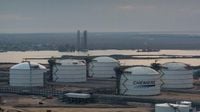In a milestone for the global energy sector, the United States shattered records in October 2025 by exporting 10.1 million metric tonnes (mmt) of liquefied natural gas (LNG) in a single month, according to preliminary data from financial firm LSEG and reported by Reuters. This achievement cements the U.S.’s position as the world’s largest LNG exporter, highlighting its rapidly growing influence in international energy markets. Yet, this record-setting surge comes at a time when scrutiny of the environmental and community impacts of LNG export terminals is intensifying, sparking a national debate about the costs and benefits of America’s LNG boom.
The October export figures represent a leap from the previous record of 9.1 mmt set just a month earlier. This growth has been propelled by the start-up of Venture Global’s Plaquemines export plant in Louisiana, which sold 2.2 mmt in October—up from 1.6 mmt in September—and the ramp-up of Cheniere’s Corpus Christi Stage 3 project, which also hit a new high with 1.6 mmt exported. Cheniere’s Sabine Pass facility contributed another 2.6 mmt, bringing Cheniere’s combined total to 4.2 mmt, or 42% of all U.S. LNG exports that month. Venture Global and Cheniere together accounted for a staggering 72% of the nation’s LNG exports in October, according to LSEG data.
Europe remained the primary destination for U.S. LNG, importing 6.9 mmt—nearly 69% of total exports—up from 6.22 mmt in September. As the continent braced for winter, European buyers continued to fill storage at a brisk pace. Exports to Asia also climbed, reaching 1.96 mmt in October compared to 1.63 mmt in September, while shipments to Latin America dipped to 0.57 mmt as the region prepared for warmer summer months. Egypt purchased five cargoes totaling 0.43 mmt, a slight decrease from the previous month, and Senegal received two cargoes totaling 0.1 mmt.
Despite this commercial triumph, the U.S. LNG industry faces mounting criticism over its environmental record. A new report by the Environmental Integrity Project (EIP), released on October 29, 2025, found that all seven U.S. LNG export terminals violated federal air pollution laws over the past five years. Based on data from the Environmental Protection Agency and state records, the report documented 425 emission incidents since 2016, resulting in the release of more than 14,000 tons of air pollution. In 2023 alone, these facilities emitted 18.2 million tons of greenhouse gases—the equivalent of emissions from 3.9 million cars—alongside 15,733 tons of air pollutants, including nitrogen oxide and benzene, both known carcinogens.
The EIP report also pointed to water pollution violations at five of the seven terminals, with illegal discharges of oil, grease, zinc, copper, and bacteria into local waterways. Despite hundreds of violations, the industry has faced only $1 million in penalties, a figure that critics argue is woefully inadequate given the scale of the infractions.
“Given the LNG industry’s terrible compliance record, our conclusion is that state and federal agencies should be slowing down and more carefully scrutinizing new applications for LNG export projects, instead of speeding up permit reviews,” said Alexandra Shaykevich, research manager at the Environmental Integrity Project and author of the report.
Some of the most serious incidents occurred at the Freeport LNG terminal in Texas, which has received seven enforcement orders and $669,604 in penalties over five years. A dramatic explosion in June 2022 sent a 450-foot fireball into the air, forcing an eight-month shutdown. Investigators determined the blast was caused by a blocked pipe valve, inadequate operating procedures, and worker fatigue.
In Louisiana, the Cameron LNG facility experienced 89 incidents between 2019 and 2025 due to failures of thermal oxidizers—devices designed to burn off toxic pollutants—releasing nearly 950,000 pounds of pollution. The facility released 1,486 pounds of benzene across 42 incidents, far exceeding its annual limit. In some cases, state regulators responded not by levying penalties, but by adjusting permits to allow more pollution. For example, Texas regulators granted Corpus Christi LNG three permit amendments that increased allowable emissions by 60%.
The LNG industry, for its part, disputes the EIP’s findings. Charlie Riedl, executive director at the Center for LNG, called the report’s conclusions “mischaracterizations,” particularly regarding year-over-year emissions and the suggestion that exporting LNG raises domestic prices. Riedl cited Department of Energy studies forecasting that U.S. natural gas prices will remain “relatively flat” through 2040, asserting, “The U.S. LNG industry operates in a highly regulated environment, with oversight at the local, state and federal levels.” Riedl also noted that the EIP is involved in litigation against an LNG export facility, suggesting the group has a “vested interest in stopping U.S. LNG project development.”
Meanwhile, local communities living near LNG export terminals are voicing concerns about the impacts on their health and livelihoods. John Allaire, a retired oil and gas engineer residing near the Calcasieu Pass LNG terminal, described the disruption caused by the facility’s routine flaring. “I can see the flames at night. Sometimes there’s black smoke. I can hear the alarms going off,” Allaire said during a press conference. James Hyatt, executive director of For a Better Bayou in Louisiana, reported that local fishermen have seen their catches drop by more than 50%. “The folks who live in the town of Cameron, less than a mile from these terminals, are mostly fishermen, and they depend on this waterway,” Hyatt said, describing the environmental consequences as “another symptom of a regulatory apparatus that does not work to protect the people.”
As the U.S. LNG sector eyes further expansion—33 new or expanded terminals have been proposed, potentially tripling exports over the next decade—the debate over its future is intensifying. Supporters argue that LNG exports bolster the U.S. economy, strengthen global energy security, and provide a cleaner alternative to coal for overseas buyers. Critics, however, warn that unchecked growth could exacerbate pollution, harm local communities, and undermine efforts to combat climate change.
Notably, the long-term outlook for LNG projects remains optimistic among industry leaders, with stable prices and sustained demand forecasted. Cheniere’s CEO Jack Fusco recently stated that, once completed, the Corpus Christi Stage 3 expansion will enable the company to export more than 50 million metric tonnes of LNG per year starting in 2026. Yet, with benchmark gas prices at Europe’s Dutch Title Transfer Facility and Asia’s Japan Korea Marker hovering close—$10.88 and $11.11 per million British thermal units, respectively, in October—there’s little incentive for exporters to shift their focus from Europe to Asia.
The story of U.S. LNG is one of remarkable growth, complex trade-offs, and unresolved tensions between economic ambition and environmental stewardship. As the nation celebrates its new export record, the question of how to balance prosperity with responsibility remains as urgent—and as contentious—as ever.




